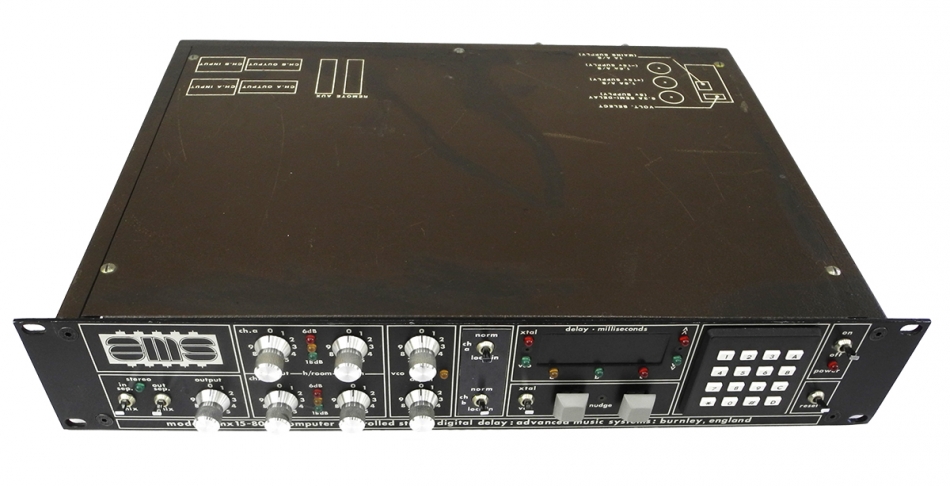

- #AMS DMX 15 80S DIGITAL DELAY DRIVER#
- #AMS DMX 15 80S DIGITAL DELAY PRO#
- #AMS DMX 15 80S DIGITAL DELAY SERIES#
dmx 15 ”While Jones likened the Rooneys to NFL royalty, Rooney’s personal touch and irrepressible good natu.
#AMS DMX 15 80S DIGITAL DELAY SERIES#
dmx 15 lahoma City’s Russell Westbrook and Houston’s James Harden for that trophy will be decided before the Thunder-Rockets series starts. MVP Harden, who has put up numbers that would make him a lock for league MVP in almost any other sea.
#AMS DMX 15 80S DIGITAL DELAY DRIVER#
It's about time: the impact of the AMS digital delay AMS Neve DMX 15-80s Computer Controlled Digital Delay Effect Spheremusic - Bargain or auction detail AMS DMX 15-80S Stereo Digital Delay from 1978 | Vintage Digital MASSIVE DMX 15 15\ Cable De Señal Dmx Xlr A Xlr 4.5mt 15p Dmx-15 American Cable LED Driver DMX 100-700mA 15W - DMX-15-100-700-E1A1
#AMS DMX 15 80S DIGITAL DELAY PRO#
Is Down.Ams-dmx-15-80s - SonicScoop Location NEVE AMS DMX 15/80 S Paris AMS DMX 15-80s Digital Delay - Ocsidance Spheremusic - Bargain or auction detail AMS DMX 15-80S - Stereo Digital Delay FOR SALE AMS DMX 15-80s Digital Delay - Ocsidance Pro Audio DRIVER LED DMX 15 - Dos Garcia S. Schroeder Reverbs: the forgotten algorithm.ValhallaRoom Tips and Tricks: Unnatural Hall Reverbs.Reverbs: Diffusion, allpass delays, and metallic artifacts.Algorithmic Reverbs, Distortion, and Noise.Seancostello on Slides from my AES Reverb… Seancostello on Early examples of modulated…Ĭharlie Domingo on Early examples of modulated… In my next post, I will analyze the contributions of these elements to the shimmer sound, and will discuss how the various components respond in a feedback situation. The common elements always seem to be the pitch shifter, a modulated reverb and/or a modulated delay line, and feedback and equalization generated via an analog mixer. In addition, modulated delay lines, such as the Lexicon Prime Time, have been used by Lanois at different times. Other accounts of the “shimmer” sound refer to different reverbs being used, such as the EMT250. The resulting sound is not a terribly accurate simulation of a real concert hall, but rather a lush and spatially expansive reverb that is still sought after more than 30 years after its introduction. The Concert Hall algorithm is also distinguished by its high degree of modulation. This algorithm has a fairly low initial echo density, that builds to a higher density as the decay evolves. The “224 Hall setting” that Killen refers to is the Concert Hall algorithm in the Lexicon 224. The circuitry on this card added a “smart” algorithm to pitch change, adjusting the transitions to better match voltages at the in and out points. Both Eventide (on the H949) and AMS partially resolved this by adding “de-glitch” cards. The Eventide H910 exhibited this, along with the early AMS Harmonizers. The result was a sort of low level crackle, more obvious with certain kinds of program material, and more audible at extreme pitch change settings. When the out and in points had different voltage levels, a small DC pop could be heard at each transition. Harmonizers, at least the early ones, had to electronically “splice” sections of the waveform in order to accomplish pitch change. Eno and Lanois have both sung the praises of this unit, and Wendy Carlos has said that the AMS unit had “perhaps the least audible artifacts to pitch shifting available at that time.”ĭavid Kulka has written that the AMS DMX had an optional de-glitch card installed, which worked on a similar principle to the auto-correlation deglitcher in the H949. The AMS DMX 15-80s was a digital delay / sampler / pitch shifter that was in common use in Britain in the early 1980’s. We may have added a second delay but then the delays have to be timed to the track as the net effect is blurring the chord progression…Our last tweak would be to play with the sends on all of the returns to the point that its almost recirculating out of control, which in turn is creating a layer upon layer effect. This return may have been equalised also.


On its fader return, some hi frequencies were rolled off, then it was fed into a 224 Hall setting, probably 5 seconds but with a rolloff in the top and bottom. The delay and modulation was derived from the AMS 1580. Kevin Killen, answering a question about the signal flow on the U2 song “4th of July” on Gearslutz, described the signal path as follows: This is the same technique used by ValhallaShimmer, with the reverberation, pitch shifting and feedback all incorporated within the same plugin. By controlling the gain and equalization of the feedback loop, and the lengths of the various delays within the loop, the temporal evolution of the sound can be altered from steel drum-esque sounds to the slow attack “string pads” hear on many of the Eno/Lanois tracks. The basic foundation of the Brian Eno / Daniel Lanois shimmer sound is fairly simple: Create a feedback loop, incorporating a pitch shifter set to +1 octave, and a reverb with a fairly long decay time.


 0 kommentar(er)
0 kommentar(er)
